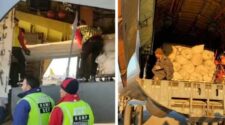Sweera Shehzad
Student BS Public Administration
 Pakistan faces numerous challenges and instability on multiple fronts. One of the major challenges is terrorism and extremism, with various militant groups operating within its borders. These groups pose a threat to national security and have been responsible for countless acts of violence and instability. Another significant challenge is the weak economy and high levels of poverty, which contribute to social unrest and political instability. Corruption and a lack of transparent governance exacerbate these problems, hindering economic growth and the delivery of essential services. Additionally, Pakistan faces regional tensions, particularly with neighboring India and Afghanistan, which further strain its stability. Ethnic and sectarian divisions within the country also contribute to social and political instability. Addressing these challenges and achieving stability in Pakistan requires comprehensive efforts in the areas of security, economy, governance, and diplomacy.
Pakistan faces numerous challenges and instability on multiple fronts. One of the major challenges is terrorism and extremism, with various militant groups operating within its borders. These groups pose a threat to national security and have been responsible for countless acts of violence and instability. Another significant challenge is the weak economy and high levels of poverty, which contribute to social unrest and political instability. Corruption and a lack of transparent governance exacerbate these problems, hindering economic growth and the delivery of essential services. Additionally, Pakistan faces regional tensions, particularly with neighboring India and Afghanistan, which further strain its stability. Ethnic and sectarian divisions within the country also contribute to social and political instability. Addressing these challenges and achieving stability in Pakistan requires comprehensive efforts in the areas of security, economy, governance, and diplomacy.
The primary challenges faced are unemployment and inflation. However, in an open economy, additional concerns arise such as the balance of payment deficit and the depreciation of the local currency against foreign currencies, particularly the US dollar. Regardless of the economic system, the central issue often revolves around low productivity and inefficiencies in the four factors of production: land, labor, capital, and organization. The Karachi Stock Exchange has experienced a significant decline due to high inflation and trade deficit, leading to a decrease in investor confidence. The market value of value stocks tends to be directly influenced by inflation rates, meaning that as inflation rises, value stocks tend to perform better. On the other hand, growth stocks, which generate minimal cash flows, exhibit a negative correlation with inflation rates.
Out of Pakistan’s population of 230 million, approximately 30% are below the age of 18 and are therefore excluded from the labor force. However, it is noteworthy that even children as young as 10 years old are engaged in child labor. Additionally, 10% of the population is above 60 years old, and due to a lack of pensionable employment in the private sector and various constraints in Pakistan, many elderly individuals are forced to seek paid employment. Out of the adult workable population comprising 60% (approximately 140 million), the labor force consists of around 70 million individuals. This means that nearly half of the adult population is not part of the labor force, with a majority of them, particularly women, working as home-based or unpaid self-employed workers in rural areas. According to World Bank data, the unemployment rate in Pakistan in 2022 was 7%, equivalent to almost 5 million people. When accounting for an additional 4 million youth turning 18 years old and those rendered unemployed due to floods, the figure rises to 12 million. Consequently, the country needs to generate jobs for these 12 million individuals in 2023, while the GDP growth rate hovers around 3.0%, which is roughly equivalent to the population growth rate of Pakistan.
As of April 2022, Pakistan’s consumer price index stood at 13.4%, and inflation reached 24.5% by December 2022. According to the Pakistan Bureau of Statistics, in 2022, food prices surged by 35.5%, with significant increases observed in onions (415%), tea (63.8%), wheat (57.3%), eggs (54.4%), gram whole (53.2%), and rice (46.6%). Other contributing factors to inflation include rising transportation costs (41.2%), particularly motor fuel (49.45%), as well as higher prices for clothing and footwear (17.1%) and housing and utilities (7%). The cost of living has escalated to the extent that the poor are unable to meet their basic needs, and even the middle class is struggling to cope with this unprecedented inflationary surge. Moreover, with interest rates at 16% and inflation at 23.5%, the cost of conducting business has skyrocketed, further disrupting the investment cycle in the country. To attract investment, Pakistan is offering incentives to foreign companies while highlighting its strategic location and untapped resources.
Politics is expected to dominate Pakistan’s attention in 2023, as it did in the previous year. The country’s political instability, which began with a dramatic no-confidence vote in April that ousted Prime Minister Imran Khan from office, has only intensified since then. Khan has led a popular opposition movement against the incumbent coalition government and the military, staging large rallies throughout the year. The struggle for power continues into 2023, with country-wide elections constitutionally mandated to be held by October. While the incumbent government has resisted Khan’s demand for early elections, it benefits them politically to delay them as long as possible while trying to address Pakistan’s economic crisis and underwhelming domestic performance. The government’s diplomatic foreign policy approach has fared better, but its success may not significantly impact the elections. Notably, Khan’s party still controls two out of four provinces in Pakistan: Punjab and Khyber Pakhtunkhwa. The federal government’s attempts to gain control in Punjab, the largest province, have been unsuccessful due to legal interventions. The year has commenced with Khan’s party initiating the dissolution of the Punjab and KP assemblies, applying pressure on the federal government for early elections.
The key question for politics-focused Pakistan remains the outcome of the upcoming general election. Will former Prime Minister Nawaz Sharif, brother of current Prime Minister Shehbaz Sharif, return to run as the head of his party, the PML-N? Can Imran Khan secure victory through his substantial support base, despite his confrontation with the military? Regardless of the result, it is unlikely that the country’s direction will significantly change, considering the historical context and track records of the main contenders. The ongoing political instability stems from tensions between civilian and military institutions, with military interventions having destabilizing effects. Corruption is rampant within government institutions, and nepotism fuels public outrage over the appointment of unqualified candidates. The government’s political wrangling contributes to inefficiencies in the economy, as it retains inefficient and dishonest employees at the expense of taxpayers, reducing development expenditures while increasing current expenditures. Moreover, the Pakistani Taliban, responsible for numerous terrorist attacks from 2007 to 2014, has been emboldened by the rule of the Taliban in Afghanistan, posing a regional threat to Pakistan. The group carried out approximately 150 attacks in Pakistan last year, primarily in the northwest. Pakistan’s attempts at negotiation with the TTP have repeatedly failed due to the group’s fundamental opposition to the current Pakistani state and constitution. The Pakistani Taliban’s sanctuary in Afghanistan limits effective action against the group within Pakistan’s borders, complicating efforts to address the TTP issue. Nevertheless, given the country’s significant political and economic challenges, the Pakistani Taliban is not currently the most pressing threat, but if left unchecked, it could escalate into a major crisis.
Pakistan has been grappling with a gas shortage for several years, and authorities should have taken action to address this crisis when it was manageable. Even now, the government, gas authorities, and companies do not seem to be sufficiently motivated to provide consumers with affordable alternatives. The shortage directly affects more than half of the population, particularly women and children who constitute a significant portion of consumers. The protests against power outages that Pakistanis have been staging for over two decades have now extended to include protests against the gas shortage. The sight of women from a conservative area like Lakki Marwat, Khyber Pakhtunkhwa, taking to the streets to protest against gas outages is alarming and should serve as a warning to the authorities. Failure to provide alternatives to the gas shortage may lead to an increase in protests, potentially spreading to other regions of the country. At the end of my piece of opinion, I express my gratitude to the esteemed Sir Dr. Muhammad Akram Zaheer for his invaluable guidance in composing this piece. He graciously bestowed upon me his time and wisdom, offering me valuable feedback and constructive critique that have greatly enhanced the caliber of my work. His patience, encouragement, and eagerness to partake in profound discussions have served as a true source of inspiration.
Contact Author: sawerashahzad18@gmail.com











